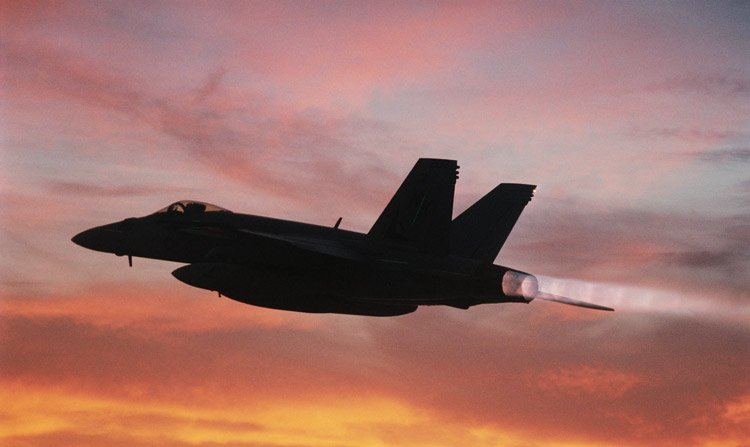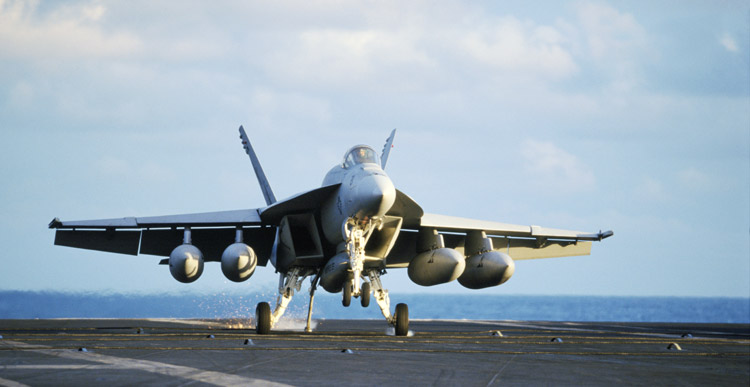INDIAN ARMED FORCES CHIEFS ON
OUR RELENTLESS AND FOCUSED PUBLISHING EFFORTS

SP Guide Publications puts forth a well compiled articulation of issues, pursuits and accomplishments of the Indian Army, over the years

I am confident that SP Guide Publications would continue to inform, inspire and influence.

My compliments to SP Guide Publications for informative and credible reportage on contemporary aerospace issues over the past six decades.
F/A-18 Super Hornet: Addressing India's Fighter Requirements
As operational theatres become increasingly connected and digital, India's future fighter fleet will need to be compatible with the upcoming aircraft and battle systems of India's armed forces.
Attributes of Future Fighters
Fighter aircraft of the future will need to possess two key attributes - networked and survivable.
The next generation of aircraft, will need to connect into a network, plugging into an information stream shared across its fleet. This means integrated and varied sensors, large computers, big data networks, and advanced displays to help aircrew manage all of the available Information.
Survivability is often confused with stealth, but stealth is just one element. Next generation aircraft will need to balance stealth with lethality - rails at range. Future fights will require increased magazine depth and sophisticated air to air sensors to deal with advanced threats. Survivability means that future fighters need to have increased range to push the threat further away.
Another aspect of survivability is reliability, especially in a ship board environment. Carrier aircraft need to be tough, easy to launch, easy to land, and easy to maintain. This is increasingly important in a time when deployments are longer and farther away than ever before. Ease of maintenance will only become more important as sensors and systems continue to grow in sophistication and complexity.
With multi-role capabilities, advanced technologies with room to grow and low acquisition and sustainment costs, the F/A-18 Super Hornet is the clear choice for India. With designed-in stealth, an AESA radar and many other advanced technologies that are ideal for mission requirements of the armed forces, the F/A-18 Super Hornet is the most advanced aircraft of its kind in operation today and will provide operational benefits to the existing and future force structure of the Indian armed forces.

F/A-18 Super Hornet: A Combat Proven Fighter
Boeing's Super Hornet is a proven platform that offers the best of the attributes of the fighter of the future - networking, survivability and reliability. Introduced in 2007, the F/A-18 Super Hornet is the world's preeminent carrier capable aircraft and best suited for India's naval fighter requirements - designed from day one for carrier operations. The Super Hornets are fully compatible with the Indian Navy's aircraft carriers. Extensive simulation has shown that the Super Hornet is capable of conducting STOBAR operations with a meaningful weapons and fuel load.
The platform will continue to evolve with the development of the next-generation Block III Super Hornet. The Block III configuration adds capability upgrades that include enhanced network capability, longer range, reduced radar signature, an advanced cockpit system and an enhanced communication system. The fighter's life also will be extended from 6,000 hours to 10,000 hours.
The combat proven F/A-18 Super Hornet is defined to meet the customers' flight plan to evolve to outpace future threats. The Block III Super Hornet will be the preeminent strike fighter off U.S. Navy carrier decks for decades to come, outpacing the future threat.
The Super Hornet is highly capable across the full mission spectrum and is a true multi-role aircraft, able to perform virtually every mission in the tactical spectrum, including air superiority, day/night strike with precision guided weapons, fighter escort, close air support, suppression of enemy air defenses, maritime strike, reconnaissance, forward air control and tanker missions.
This coupled with designed-in stealth and the right payload capacity, makes the Super Hornet the ideal fighter of the future for the Indian Air Force.
The Super Hornet's benefits of being a twin-engine aircraft help provide the warfighter a margin of safety that does not exist in a single-engine platform. A single-engine aircraft is likely lost due to engine malfunctions or loss of thrust while a twin-engine platform can lose an engine and still safely return to base or carrier.
Every Super Hornet has a buddy refueling capability that can extend time on station, range, and endurance. Additionally, the Super Hornet can provide close and deep air support through the Active Electronically Scanned Array (AESA) radar and reliable data links.
One look at the decks of the U.S. Navy's aircraft carriers and the Royal Australian Air Force's fleet and you'll see advanced, combat-proven strike capability. The Super Hornet is the multi-role solution for the Navy and international air force customers.

Ease of maintenance
The F/A-18 Super Hornet not only has a low acquisition cost, but it costs less per flight hour to operate than any other tactical aircraft in U.S. forces inventory. Part of its affordability is because the Super Hornet is designed to need far less maintenance; this translates into high mission availability. Ease of maintenance (supportability) results in lower maintenance man-hours per flight hour.
Plus, the Super Hornet does not require any scheduled depot-level maintenance and the engine does not require any scheduled maintenance between overhauls.
Further, Boeing's active production line and robust supply chain allow the company to offer the most affordable platform.
This low cost of operation, low maintenance requirements and twin-engine based survivability allow the Super Hornet to fly to and back from harsh environments.
F/A-18 Super Hornet Make in India
Boeing has had a presence in India for more than seven decades and is committed to expanding that partnership by producing Super Hornets in India, further developing India's aerospace ecosystem.
In 2018 Boeing announced a partnership with Hindustan Aeronautics Limited (HAL) and Mahindra Defence Systems (MDS) for manufacturing the F/A-18 Super Hornet in India for its armed forces and pursuing the joint development of future technologies. The partnership will transform India's aerospace and defense ecosystem, further building on its 'Make in India' success.
Boeing's proposed 'Make in India' plans for the Super Hornet are not about moving a production line but rather building an entirely new, state-of-the-art production facility that can be utilized for other programs like India's Advanced Medium Combat Aircraft program. Future production with Indian partners will also involve maximizing indigenous content and producing the F/A-18 in India for its armed forces to create a 21st century aerospace ecosystem.
With advanced technologies and multi-role capabilities, the Super Hornet is perfectly suited to meet the needs of the Indian Navy and Indian Air Force now and in the future.





